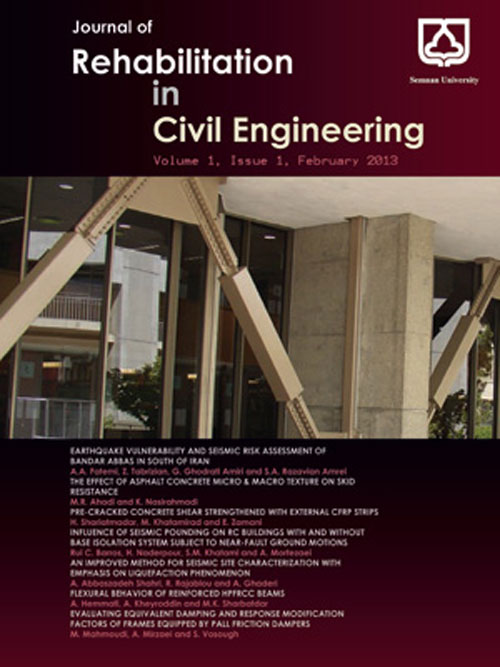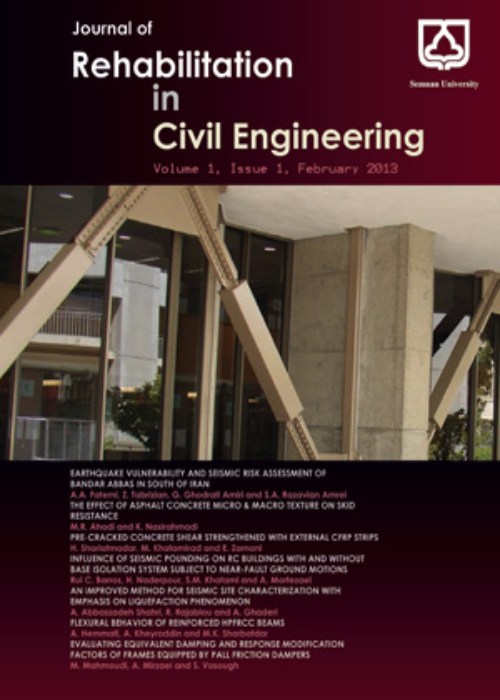فهرست مطالب

Journal of Rehabilitation in Civil Engineering
Volume:4 Issue: 1, Winter - Spring 2016
- تاریخ انتشار: 1395/03/25
- تعداد عناوین: 7
-
-
Pages 1-17This paper deals with the modelling of punching shear failure in reinforced concrete slabs using nonlinear finite element analysis. The 3D finite element analyses (FEA) were performed with the appropriate modeling of element size and mesh, and the constitutive modeling of concrete. The FE numerical models are validated by comparing with the experimental results obtained from tested specimens and previous research. One slab served as control without any modification while three slabs were strengthened. Ultimate behavior of FRP strengthened RC flat slabs under a centrally applied load. Each method of repair or strengthening is reviewed with emphasis on its performance with respect to the application details. The punching shear capacity, stiffness, ductility were investigated. In addition, the analytical results were compared with the predictions using the provision of ACI 318-08. The results showed that for control slab and strengthened specimens an increase varied from 4% to 105% in punching shear capacity is determined.Keywords: RC flat slab, Strengthening, Punching shear
-
Pages 18-30In the MechanisticEmpirical Pavement Design Guide (MEPDG), dynamic modulus of asphalt mixes are used as one of the input parameters in pavement analysis and design. For in-service pavements, MEPDG method uses a combination of some field and laboratory tests for structural evaluation of asphalt layers in rehabilitation projects. In this study, ten new and rehabilitated in-service asphalt pavements with different physical characteristics were selected in provinces of Khuzestan and Kerman in south of Iran. These provinces are known as hot climate areas and have sever climatic conditions. At each site, Falling Weight Deflectometer (FWD) testing was conducted and core samples were taken. These samples were extracted and mix volumetric properties and bitumen characteristics were determined. The results of these tests were used as input parameters in Witczak dynamic modulus prediction model for determination of MEPDG undamaged dynamic modulus master curves. Finally, the damaged (in-situ) dynamic modulus master curves were developed upon modifying the undamaged master curves with the damage factors determined from backcalculation analysis of FWD data. It was found that with the above mechanistic-empirical procedure, it would be possible to successfully evaluate in-service asphalt layers located in sever climatic areas.Keywords: Asphalt Dynamic Modulus, FWD, MEPDG, Pavement Rehabilitation
-
Pages 31-44During recent years, the use of fiber reinforced polymers (FRP) as a desirable alternative for improving the behavior of lateral resisting system are known. There are various factors influencing on the quality of such kind of rehabilitation. This study aims to investigate the influence of geometric characteristics and arrangement of FRP layers on rehabilitating of concrete shear walls. A few reinforced concrete shear walls with different thickness and arrangement of FRP layers were analyzed by ABAQUS finite element model software, under gravity and lateral loads. The results indicated that the variation of shear wall strength is considerable due to confinement provided by the FRP layers based on the influence of thickness and arrangements. It is seen that, the performance of Chess and Cross layers of FRP are more effective than other arrangements for improving the final strength of reinforced concrete shear wall. It is also observed that, by increasing the FRP thickness, the wall performance against lateral loading will be improved considerably.Keywords: Seismic rehabilitation, Concrete shear wall, Arrangement of FRP layers, FRP layers thickness
-
Pages 45-60In this paper evaluation of seismic capacity of a historical building is carried out. It had been used as a national library about 40 years ago. Also, before that, it had been constructed as a part of a Royal complex. This building has been constructed by traditional methods using bricks and mortars. The ceilings system of the structure consists of jack arches. Also, the roof of the building has been constructed with wood trusses. The building does not have any designed lateral bearing system. Lateral resistant of the building is due to masonry walls and due to brittle and non-ductile performance of it. In secondary cycles of earthquake vibration, it will loose its stiffness and strengthening radically. Also the building does not have any reliable about integrity. Load bearing systems are not reliable too. In this paper the evaluation of resistant capacity of the building is established and the weak points of the system are distinguished. For some masonry columns some traditional method of steel jacketing is designed and for increasing the reliability of the columns, FRP sheets are applied. In order to retrofits the walls, FRP sheets are installed on its surfaces, the externally bonded FRP sheets are strengthening the wall against in-plane and out of plane applied horizontal forces. Combination of the steel jacketing and externally bonded FRP sheets is prescribed to achieve an integrated system of the elements.Keywords: URM, masonry, retrofit, historical building, FRP
-
Pages 61-74The initial consolidation settlement process of saturated cohesive soils has been one of the most important issues to geotechnical engineers especially in important and sensitive structures based which are located on saturated clay layer with high thickness. In dealing with initial consolidation settlement process and reducing its negative and destructive consequences, a number of solutions have been presented including but not limited to the implementation sand drainages, pre-loading and dynamic compaction; limitations of these methods include the necessity of implementing them before construction of the project. On the other hand, if the underground water level goes lower than regarded values, no appropriate approach else than the overhead reduction approach has been provided. In present research, with addition of concentrations of 250, 750 and 1250 Mg/lit in saturated water, laboratory study of the changes in initial consolidation settlement process, were investigated by standard Oedometer test device upon the addition of different concentrations of the cations, dissolved in saturated water on cylindrical samples of Bojnord clay with 2 cm in height and 7.5 cm in diameter. Achieved results represent significant changes in quantities of initial consolidation settlement process upon adding a variety of dissolved cations in saturated water; The results show that application of cations with different concentrations changes the values of initial consolidation settlement values in appropriate with type and concentration of cations that the highest reduction of the initial consolidation settlement of Bojnord clay valued at 24.61% for the sample made with Al cation with ionic concentration of 1250 Mg/lit.Keywords: Initial consolidation settlement, clay, Oedometer test, Bojnord
-
Pages 75-90In research or experimental works related to blast loads, amount of explosion material and distance of explosion point are very important. So, in this paper has been attempted to present a parametric study of the reactive powder concrete subjected to blast load. The effect of different amount of TNT adopted the literature, distance of explosion point from RPC slab and also location of explosion charge (horizontal and vertical coordinates form the center of specimens) has been investigated. In order to analytical simulation of RPC behavior against blast and also accuracy of acquired results, at first using ABAQUS software, a RPC slab studied in the literature has been verified. The obtained results are showed that the simulated model of RPC is match with literature one. In the next stage a case study of the effect of explosion charge and also distance of explosion point from RPC and NSC (normal strength concrete) slabs have been examined and the results have been compared. Its noted that the NSC slab is supposed to be a reinforced concrete, whereas 2% volume of special short steel fibers were used in the RPC specimen. The acquired results have been showed that the RPC have better blast explosion resistance than reinforced normal strength concrete.Keywords: Reactive Powder Concrete (RPC), blast load, analytical simulation, explosion charge, explosion point
-
Pages 91-105Infilled walls are the major non-structural elements which have significant effects on the seismic behavior of structures. The shape and strength of the brick elements are the main parameters affect the strength of the walls. In addition existence of openings may have a reduction effect. To increase the strength of the wall and to improve its behavior, the borders of the openings may be strengthened. In this paper a one-story one-bay infilled steel frame which have been experimentally tested, is modeled numerically and analyzed by commercial software ATENA. The wall was made by hollow clay tiles and cement mortar. The infilled frame was modeled under monotonically increasing loads until the failure. The numerical model is verified by comparing the cracking shape and the load-drift curves of the experimental and numerical models. Based on this numerical model, investigations on the effect of openings with different size and locations on the in-plane behavior of the walls are conducted. The effect of the strengthening of opening borders is probed additionally. Observations showed that the effect of openings is negligible for the opening with less than 10% area of the wall. In other cases, the lateral strength of the infilled frame reduced by 20-80% based on the size and location of the openings. The strengthening of all borders of openings with L shaped steel angels can improve the behavior. Arrangement of these border elements may be changed to show better performance.Keywords: infill, opening, ATENA, L shaped strengthening, hollow clay tile


